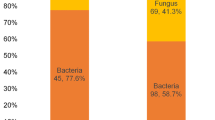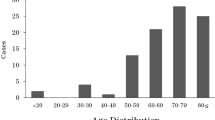Abstract
To assess the prevalence of fungal keratitis, we conducted a retrospective study over 7 years (2005 through 2011) at a tertiary care center in North India. Effort has been made to analyze the disease burden, spectrum of agents and treatment history. The findings were compared with an earlier study at the same center for any change in the epidemiology of the disease. Microbiology records were screened at the Postgraduate Institute of Medical Education and Research, Chandigarh, India, to identify fungal keratitis cases, and available clinical records of those cases were analyzed. Of 2459 clinically suspected fungal keratitis cases, 765 (31 %) cases were direct microscopy confirmed. Of these microscopy-confirmed cases, fungi were isolated in 393 (51.4 %), with Aspergillus spp. ranked top (n = 187, 47.6 %), followed by melanized fungi (n = 86, 21.9 %) and Fusarium spp. (n = 64, 16 %). A male predominance of 78.7 % was noted with a peak in the incidence of fungal keratitis during post-monsoon season (September to November). A delay in diagnosis was significantly associated (p < 0.001) with keratitis cases due to melanized fungi. In comparison with an earlier study, higher isolation of melanized fungi was noted with a widening of the spectrum of agents identified. Thus, fungal keratitis due to Aspergillus spp. remains a serious ocular illness among the active male population in North India with relative rise of keratitis due to melanized fungi. The spectrum of agents causing fungal keratitis has broadened with many rare fungi that are implicated.

Similar content being viewed by others
References
Whitcher JP, Srinivasan M. Corneal ulceration in the developing world—a silent epidemic. Br J Ophthalmol. 1997;81:622–3.
Whitcher JP, Srinivasan M, Upadhyay MP. Corneal blindness: a global perspective. Bull World Health Organ. 2001;79:214–21.
Chowdhary A, Singh K. Spectrum of fungal keratitis in North India. Cornea. 2005;24:8–15.
Dunlop AA, Wright ED, Howlader SA, et al. Suppurative corneal ulceration in Bangladesh. A study of 142 cases examining the microbiological diagnosis, clinical and epidemiological features of bacterial and fungal keratitis. Aust N Z J Ophthalmol. 1994;22:105–10.
Gopinathan U, Garg P, Fernandes M, Sharma S, Athmanathan S, Rao GN. The epidemiological features and laboratory results of fungal keratitis: a 10-year review at a referral eye care center in South India. Cornea. 2002;21:555–9.
Upadhyay MP, Karmacharya PC, Koirala S, et al. Epidemiologic characteristics, predisposing factors, and etiologic diagnosis of corneal ulceration in Nepal. Am J Ophthalmol. 1991;111:92–9.
Xie L, Zhong W, Shi W, Sun S. Spectrum of fungal keratitis in north China. Ophthalmology. 2006;113:1943–8.
Thomas PA, Kaliamurthy J. Mycotic keratitis: epidemiology, diagnosis and management. Clin Microbiol Infect. 2013;19:210–20.
Rautaraya B, Sharma S, Kar S, Das S, Sahu SK. Diagnosis and treatment outcome of mycotic keratitis at a tertiary eye care center in eastern India. BMC Ophthalmol. 2011;11:39.
Thomas PA. Fungal infections of the cornea. Eye. 2003;17:852–62.
Bandyopadhyay S, Das D, Mondal KK, Ghanta AK, Purkrit SK, Bhasrar R. Epidemiology and laboratory diagnosis of fungal corneal ulcer in the Sundarban Region of West Bengal, eastern India. Nepal J Ophthalmol. 2012;4:29–36.
Chander J, Singla N, Agnihotri N, Arya SK, Deep A. Keratomycosis in and around Chandigarh: a five-year study from a north Indian tertiary care hospital. Indian J Pathol Microbiol. 2008;51:304–6.
Manikandan P, Varga J, Kocsube S, et al. Epidemiology of Aspergillus keratitis at a tertiary care eye hospital in South India and antifungal susceptibilities of the causative agents. Mycoses. 2013;56:26–33.
Tewari A, Sood N, Vegad MM, Mehta DC. Epidemiological and microbiological profile of infective keratitis in Ahmedabad. Indian J Ophthalmol. 2012;60:267–72.
Chander J, Sharma A. Prevalence of fungal corneal ulcers in northern India. Infection. 1994;22:207–9.
de Hoog GS, Figueras MJ. Atlas of clinical fungi. 2nd ed. Washington, DC: ASM Publisher; 2001.
Rd SJ. Molecular cloning: a laboratory manual. New York: Cold Spring Harbor Laboratory Press; 2001.
White TJBT, Lee S, Taylor J. Amplification and direct sequencing of fungal ribosomal RNA genes for phylogenetics. New York: Academic Press; 1990.
Sandhu DK, Randhawa IS, Singh D. The correlation between environmental and ocular fungi. Indian J Ophthalmol. 1981;29:177–82.
Saha S, Banerjee D, Khetan A, Sengupta J. Epidemiological profile of fungal keratitis in urban population of West Bengal, India. Oman J Ophthalmol. 2009;2:114–8.
Satpathi P, Satpathi S. Study of microbial keratitis in central India. J Infect Dev Ctries. 2012;6:295–8.
Tilak R, Singh A, Maurya OP, Chandra A, Tilak V, Gulati AK. Mycotic keratitis in India: a five-year retrospective study. J Infect Dev Ctries. 2010;4:171–4.
Gopinathan U, Sharma S, Garg P, Rao GN. Review of epidemiological features, microbiological diagnosis and treatment outcome of microbial keratitis: experience of over a decade. Indian J Ophthalmol. 2009;57:273–9.
Rondeau N, Bourcier T, Chaumeil C, et al. Fungal keratitis at the Centre Hospitalier National d’Ophtalmologie des Quinze-Vingts: retrospective study of 19 cases. J Fr Ophtalmol. 2002;25:890–6.
Bharathi MJ, Ramakrishnan R, Meenakshi R, Padmavathy S, Shivakumar C, Srinivasan M. Microbial keratitis in South India: influence of risk factors, climate, and geographical variation. Ophthalmic Epidemiol. 2007;14:61–9.
Basak SK, Basak S, Mohanta A, Bhowmick A. Epidemiological and microbiological diagnosis of suppurative keratitis in Gangetic West Bengal, eastern India. Indian J Ophthalmol. 2005;53:17–22.
Lin CC, Lalitha P, Srinivasan M, et al. Seasonal trends of microbial keratitis in South India. Cornea. 2012;31:1123–7.
Kredics L, Narendran V, Shobana CS, Vagvolgyi C, Manikandan P, Indo-Hungarian Fungal Keratitis Working G. Filamentous fungal infections of the cornea: a global overview of epidemiology and drug sensitivity. Mycoses. 2015;58:243–60.
Kunimoto DY, Sharma S, Garg P, Gopinathan U, Miller D, Rao GN. Corneal ulceration in the elderly in Hyderabad, south India. Br J Ophthalmol. 2000;84:54–9.
Pm AEM. Clinical mycology. New York: Churchill Livingstone; 2009.
Stevens DA, Kan VL, Judson MA, et al. Practice guidelines for diseases caused by Aspergillus. Infectious Diseases Society of America. Clin Infecti Dis. 2000;30:696–709.
Author information
Authors and Affiliations
Corresponding author
Electronic supplementary material
Below is the link to the electronic supplementary material.
Rights and permissions
About this article
Cite this article
Ghosh, A.K., Gupta, A., Rudramurthy, S.M. et al. Fungal Keratitis in North India: Spectrum of Agents, Risk Factors and Treatment. Mycopathologia 181, 843–850 (2016). https://doi.org/10.1007/s11046-016-0042-3
Received:
Accepted:
Published:
Issue Date:
DOI: https://doi.org/10.1007/s11046-016-0042-3




